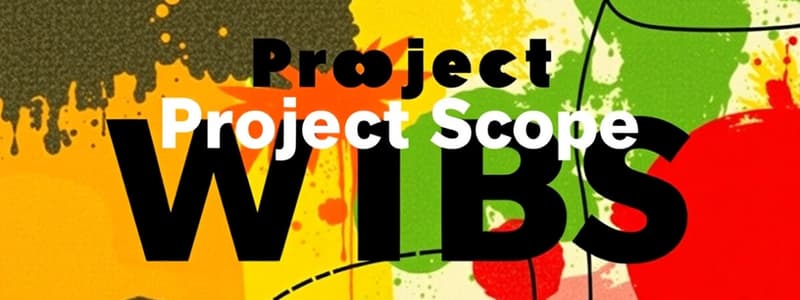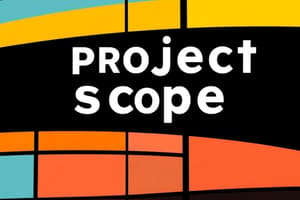Podcast
Questions and Answers
Which of the following best describes the primary purpose of project scope management?
Which of the following best describes the primary purpose of project scope management?
- To ensure the project adheres to the allocated budget by controlling costs effectively.
- To guarantee that the project includes all the work required, and only the work required, to complete the project successfully. (correct)
- To foster effective communication among stakeholders, ensuring everyone is aligned and informed.
- To manage and mitigate risks that could impact the project's timeline and deliverables.
What is a 'deliverable' in the context of project scope management?
What is a 'deliverable' in the context of project scope management?
- A product produced as part of a project, such as hardware, software, or planning documents. (correct)
- The total budget allocated for a project.
- A risk factor that could potentially impact the project timeline.
- A constraint imposed by the project sponsor.
Which process involves formalizing the acceptance of project deliverables?
Which process involves formalizing the acceptance of project deliverables?
- Collecting requirements
- Defining scope
- Validating scope (correct)
- Controlling scope
What is the main purpose of the 'collecting requirements' process in project scope management?
What is the main purpose of the 'collecting requirements' process in project scope management?
Which document describes a 'condition or capability that is necessary to be present in a product, service, or result to satisfy a business need'?
Which document describes a 'condition or capability that is necessary to be present in a product, service, or result to satisfy a business need'?
What is the primary function of a requirements traceability matrix (RTM)?
What is the primary function of a requirements traceability matrix (RTM)?
What is the purpose of defining the scope of a project?
What is the purpose of defining the scope of a project?
A project manager is using a technique that involves subdividing major project deliverables into smaller, more manageable components. What is this technique called?
A project manager is using a technique that involves subdividing major project deliverables into smaller, more manageable components. What is this technique called?
What is the primary output of the 'Create WBS' process?
What is the primary output of the 'Create WBS' process?
Which of the following best describes the 'analogy approach' for creating a Work Breakdown Structure (WBS)?
Which of the following best describes the 'analogy approach' for creating a Work Breakdown Structure (WBS)?
What is the purpose of a WBS dictionary?
What is the purpose of a WBS dictionary?
In project management, what does 'scope creep' refer to?
In project management, what does 'scope creep' refer to?
What is the primary goal of scope control?
What is the primary goal of scope control?
What does 'variance' mean in the context of scope control?
What does 'variance' mean in the context of scope control?
In agile/adaptive environments, how is project scope typically managed?
In agile/adaptive environments, how is project scope typically managed?
Which of the following is a suggestion for improving user input during project scope management?
Which of the following is a suggestion for improving user input during project scope management?
Which activity is part of the 'planning scope management' process?
Which activity is part of the 'planning scope management' process?
Why is it important to maintain and approve the WBS?
Why is it important to maintain and approve the WBS?
Which of the following is a suggestion for reducing incomplete and changing requirements?
Which of the following is a suggestion for reducing incomplete and changing requirements?
Which software can be useful in developing a WBS?
Which software can be useful in developing a WBS?
Which of the following is an element of a project scope statement?
Which of the following is an element of a project scope statement?
How do stakeholders typically define and approve scope in Agile projects?
How do stakeholders typically define and approve scope in Agile projects?
What is the outcome of scope validation?
What is the outcome of scope validation?
Which of the following is NOT a suggestion for improving user input?
Which of the following is NOT a suggestion for improving user input?
What does an effective requirements management plan document?
What does an effective requirements management plan document?
Which activity is part of the 'defining scope' process?
Which activity is part of the 'defining scope' process?
Which of the following techniques can be used to collect requirements?
Which of the following techniques can be used to collect requirements?
A project team is reviewing the WBSs of similar past projects to help create one for their current project. Which approach are they using?
A project team is reviewing the WBSs of similar past projects to help create one for their current project. Which approach are they using?
Which key aspect is described by a WBS dictionary?
Which key aspect is described by a WBS dictionary?
Why is scope validation especially critical in IT projects?
Why is scope validation especially critical in IT projects?
What is the goal of scope control?
What is the goal of scope control?
For every dollar spent on projects and programs, what percentage is wasted due to poor requirements management?
For every dollar spent on projects and programs, what percentage is wasted due to poor requirements management?
Which of the following describes how Google changed their culture?
Which of the following describes how Google changed their culture?
What is the main tool or technique for creating a WBS?
What is the main tool or technique for creating a WBS?
What is the definition of a work package?
What is the definition of a work package?
What is the bottom-up approach to developing a work breakdown structure?
What is the bottom-up approach to developing a work breakdown structure?
What approach to developing work breakdown structures uses branches radiating out from a core idea to structure thoughts and ideas?
What approach to developing work breakdown structures uses branches radiating out from a core idea to structure thoughts and ideas?
What should be done to ensure consistency and buy-in when developing a WBS?
What should be done to ensure consistency and buy-in when developing a WBS?
Flashcards
What is project scope?
What is project scope?
All the work involved in creating the products of the project and the processes used to create them.
What is a deliverable?
What is a deliverable?
A product produced as part of a project, such as hardware, software, planning documents, or meeting minutes.
What is project scope management?
What is project scope management?
The processes involved in defining and controlling what is or is not included in a project.
What is planning scope management?
What is planning scope management?
Signup and view all the flashcards
What are collecting requirements?
What are collecting requirements?
Signup and view all the flashcards
What is defining scope?
What is defining scope?
Signup and view all the flashcards
What is creating the WBS?
What is creating the WBS?
Signup and view all the flashcards
What is validating scope?
What is validating scope?
Signup and view all the flashcards
What is controlling scope?
What is controlling scope?
Signup and view all the flashcards
What is a scope management plan?
What is a scope management plan?
Signup and view all the flashcards
What is a requirement?
What is a requirement?
Signup and view all the flashcards
What is a requirements management plan?
What is a requirements management plan?
Signup and view all the flashcards
What is a requirements traceability matrix (RTM)?
What is a requirements traceability matrix (RTM)?
Signup and view all the flashcards
Elements of a project scope statement.
Elements of a project scope statement.
Signup and view all the flashcards
What is a Work Breakdown Structure (WBS)?
What is a Work Breakdown Structure (WBS)?
Signup and view all the flashcards
What is decomposition?
What is decomposition?
Signup and view all the flashcards
What is the scope baseline?
What is the scope baseline?
Signup and view all the flashcards
What is a WBS dictionary?
What is a WBS dictionary?
Signup and view all the flashcards
What is the Analogy approach?
What is the Analogy approach?
Signup and view all the flashcards
What is the top-down approach?
What is the top-down approach?
Signup and view all the flashcards
What is the bottom-up approach?
What is the bottom-up approach?
Signup and view all the flashcards
What is mind mapping?
What is mind mapping?
Signup and view all the flashcards
What is scope validation?
What is scope validation?
Signup and view all the flashcards
What is controlling scope?
What is controlling scope?
Signup and view all the flashcards
What is variance?
What is variance?
Signup and view all the flashcards
What is scope creep?
What is scope creep?
Signup and view all the flashcards
Scope in Agile/Adaptive Environments?
Scope in Agile/Adaptive Environments?
Signup and view all the flashcards
Study Notes
Project Scope Management
- Project scope management involves defining and controlling what is, and is not, included in a project.
- This ensures that the project team and stakeholders have a shared understanding of project deliverables and processes.
- Scope refers to the work required to create project products and the processes involved.
- A deliverable is a product produced, such as hardware, software, documents, or minutes.
Project Scope Management Processes
- Planning scope management is determining how the project's scope and requirements will be managed.
- Collecting requirements involves defining and documenting product features and functions and the processes for creating them.
- Defining scope includes reviewing the project charter, requirements documents, and organizational assets to create a scope statement.
- Creating the Work Breakdown Structure (WBS) involves subdividing major project deliverables into smaller, manageable components.
- Validating scope is the formal acceptance of project deliverables.
- Controlling scope involves managing changes to the project scope throughout its life cycle.
Planning Scope Management
- The project team develops two outputs using expert judgment, data analysis, and meetings:
- Scope management plan
- Requirements management plan.
- The scope management plan is a subsidiary part of the overall project management plan.
- Scope management plan contents include:
- Preparing a detailed project scope statement.
- Creating a WBS.
- Maintaining and approving the WBS.
- Obtaining formal acceptance of deliverables.
- Controlling change requests.
Requirements Management Plan
- The PMBOK® Guide, Sixth Edition, defines a requirement as a necessary condition or capability in a product, service, or result to satisfy a business need.
- The requirements management plan documents how project requirements will be analyzed, documented, and managed.
- It outlines how to plan, track, and report requirements activities.
- It specifies how to perform configuration management and prioritize requirements.
- Also details how to use product metrics and trace/capture requirement attributes.
Collecting Requirements
- Ways to collect project requirements include:
- Interviewing stakeholders.
- Holding focus groups and workshops.
- Using group creativity and decision-making techniques.
- Utilizing questionnaires and surveys.
- Conducting observation studies.
- Benchmarking.
Requirements Traceability Matrix
- Requirements Traceability Matrix (RTM) is a table listing requirements, their attributes, and status, ensuring all are addressed.
- An sample RTM entry is a laptop memory, categorized as hardware, sourced from the project charter and corporate laptop specifications.
- A sample Status: laptops ordered meet memory requirement.
Defining Scope
- Key elements of a project scope statement:
- Product scope description.
- Product user acceptance criteria.
- Detailed information on all project deliverables.
- Helpful to document other information such as:
- Project boundaries.
- Constraints.
- Assumptions.
- Supporting document references.
- The project scope should become clearer and more specific as time progresses.
Media Snapshot: Inaccurate Requirements
- Inaccurate gathering of project requirements remains a primary cause of project failure.
- Poor requirements management leads to 5.1% waste of every dollar on projects and programs.
- Organizations need to improve people, processes, and culture to enhance requirements management.
Creating the Work Breakdown Structure (WBS)
- The Work Breakdown Structure (WBS) is a deliverable-oriented grouping of project work that defines the total scope.
- It serves as a foundation document for planning and managing project schedules, costs, resources, and changes.
- Decomposition, subdividing project deliverables into smaller pieces, is the main tool for creating a WBS.
- A work package is a task at the lowest level of the WBS.
- Outputs of creating the WBS are:
- The scope baseline
- Project documents updates.
- The scope baseline includes the approved project scope statement, WBS, and WBS dictionary.
Approaches to Developing Work Breakdown Structures
- Using Guidelines
- Some organizations, like the U.S. Department of Defense (DOD), provide guidelines for preparing WBSs.
- Analogy Approach
- Review WBSs of similar projects and tailor to your project.
- Top-Down Approach
- Start with the largest items of the project and break them down.
- Bottom-Up Approach
- Begin with the specific tasks.
- Mind Mapping
- Uses branches radiating from a core idea to structure thoughts and ideas.
WBS Dictionary
- Addresses vague WBS tasks by describing detailed information about each item.
- The format can vary based on project needs.
- Advice for creating includes:
- Each unit of work should appear in only one place
- The content of the work should be the sum of the items below it.
- The single individual responsible is defined, though many people may work on it.
- Consistency with actual process is key, the dictionary should serve the project team first.
- Project team involvement will ensure consistency.
- Flexibility and accurate understanding is important.
Validating Scope
- Creating a good project scope statement and WBS can be difficult.
- Especially on IT projects, verifying project scope and minimizing changes is even more challenging.
- Even with a well-defined scope, IT projects often experience scope creep, with the scope expanding.
- Scope validation involves formal acceptance of completed deliverables, often via customer inspection and sign-off.
What Went Wrong?
- A broad and grandiose project scope can lead to severe problems.
- Scope creep and an overemphasis on technology for its own sake led to a large pharmaceutical firm's bankruptcy.
- McDonald's once initiated a project to connect its headquarters with restaurants for real-time data, but stopped it due to difficulty.
- The McDonald's project ceased after spending $170 million.
Global Issues
- Many countries face difficulties controlling the scope of large projects, especially with advanced technologies and many users.
- The state government of Victoria, Australia had issues with its website for a public transportation smart card due to problems in developing and implementing it.
Controlling Scope
- Involves managing changes to the project scope while considering project goals and business strategy.
- Goals of scope control:
- Influence factors causing scope changes.
- Ensure changes are processed per integrated change control.
- Manage changes effectively.
- Variance is the difference between planned and actual performance.
Suggestions for Improving User Input
- Establish a strong project selection process with sponsors from the user organization.
- Integrate users into the project team.
- Hold regular meetings with defined agendas.
- Provide regular deliveries to users and sponsors.
- Only promise achievable deliveries.
- Locate users with developers.
Suggestions for Reducing Incomplete and Changing Requirements
- Develop and adhere to a requirements management process:
- Employ techniques for user involvement, such as
- Prototyping
- Use case modeling
- JAD.
- Document requirements in writing and keep them current.
- Create a requirements management database.
- Provide adequate testing throughout the project.
- Review changes from a systems perspective.
- Focus on completion dates.
- Allocate change request resources.
Using Software
- Word processors aid in creating scope-related documents.
- Spreadsheets and presentation software are good for charts and graphs.
- Mind-mapping software assists in WBS development.
- Communication platforms facilitate project scope information sharing.
- Project management software is vital for WBS and Gantt chart creation.
- There is specialized scope management software.
Agile and Adaptive Environments
- Stakeholders define and approve scope before each iteration, with detailed scope evolving over time.
- An agile approach results in multiple usable products throughout the project.
Chapter Summary
- Project scope management ensures the project includes all and only the necessary work.
- Main processes include defining scope management, collecting requirements, defining scope, creating WBS, validating scope, and controlling scope.
Studying That Suits You
Use AI to generate personalized quizzes and flashcards to suit your learning preferences.




